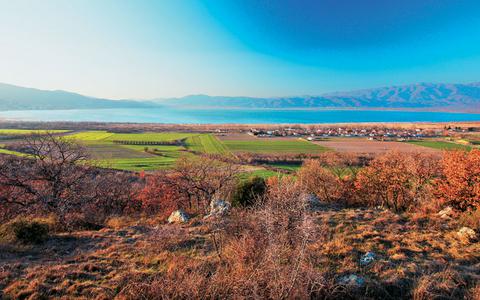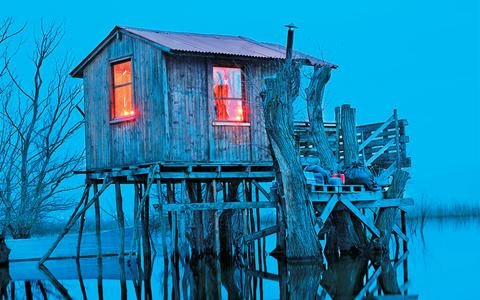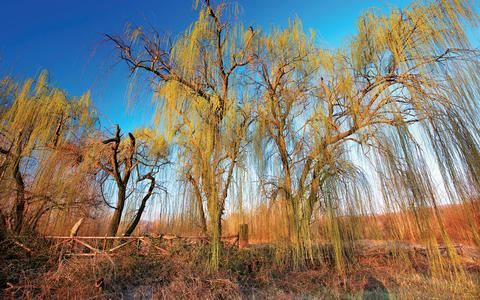Pictres: www.ethnos.gr
Although Kilkis prefecture is landlocked, water is present to a great extent here. Lake Doiran, on the border with the Republic of Macedonia, is undoubtedly the most popular attraction in the area, and not without reason, as visitors will ensure you. An (almost) straight road from Thessaloniki will lead you to the lake which comes into view with thousands of colours. The "Thousand Trees" forest is located along the lake’s banks with centuries-old oaks and sycamores.

If Lake Doiran is the occasion to visit the prefecture, you will quickly find many other reasons to visit the area again. Mount Paiko is impressive with its beautiful colours in all seasons, and the beautiful monasteries nearby add extra charm to the area. In Goumenissa, you will hear the famous Goumenissa Brass Bands and in Aksioupoli you can visit the original Natural History Museum. On the other side of the prefecture, Mount Belles rises northeast and represents the natural border between Greece and the Balkans. There are two rivers which cross the prefecture on their way to the Thermaikos Gulf – the Axios (Vardar) River and the Galliko River.
The water boundary
There is a paradox in terms of Lake Doiran, which is the natural border between Greece and Macedonia - its physical beauty is unmatched, but despite this fact, it is not much developed as a tourist destination. The lake is beautiful all year round, and it is best known by residents of Thessaloniki and Kilkis who often take a walk around it during the weekends, and not only then.
Lake Doiran covers an area of about 38-40 square kilometres. One third of this area, about 13 square kilometres, belongs to Greece and the rest - to the neighbouring country.

Doiran formed as a result of geophysical and seismic processes thousands of years ago; it is believed that it is a remnant of ancient Lake Paeonia which spread over several dozen hectares. Today, the lake is supplied with water from springs on its bed as well as from small mountain streams descending from the mountains of Krousia and Belles.

The village, which is located on the southern banks of the lake, 27 km from Kilkis, is the starting point for the tour. The small fishing village of Doiran has few remaining inhabitants, about 180, largely refugee families who settled here during the Balkan wars. Today, the majority of them are occupied in fishing in the lake, although, as they themselves say, the number of fish in Lake Doiran has significantly decreased. In the past, at the beginning of the last century, it was one of the richest lakes in terms of fish in Macedonia.
However, as a result of the excessive water consumption and because of construction works, the water level is dramatically decreasing. From 10 m depth, it has declined to 3 m today. And when the waters decrease, the fish cannot grow, say experienced fishermen from Doiran. But even in this situation, about 20 local fishermen still go out in their boats, called "plaves," in the lake to catch carp and catfish which you can try in the small taverns of the village.

An invaluable ecosystem
An exceptional fauna lives in the waters of Lake Doiran, including species which reside here permanently and ones which stop at the lake during their journey in search of food or to overwinter here. Therefore, that part of the lake which belongs to Greece is included in the list of areas under special protection. Today, the lake is home to 36 species of birds, such as the Pygmy Cormorant, Dalmatian Pelican and Glossy Ibis. In fact, these three species are considered threatened worldwide. 18 species of fish live in the waters of the lake, and the largest populations include carp and catfish, as well as common roach and perch.

The end of the route which covers about 8.5 km along the lake is just as charming - a forest of about 600 acres, dotted with ash trees, alders, oak trees as well as extremely old sycamore trees. This is one of those forests which give you a good idea of those primeval forests which once covered the whole of Macedonia. This is the “Thousand Trees“ forest - a green “lung” of rare beauty and incalculable ecological value. It is no coincidence that it has been officially declared a landmark, and is also included in the European Natura 2000 network.

The forest offers you areas to sit down and relax. The largest village of Doiran Lake, Mouries, is located only 2.5 km away. Do not miss the Mouries waterfall, located in Ano Sourmena, at the foot of Mount Belles.